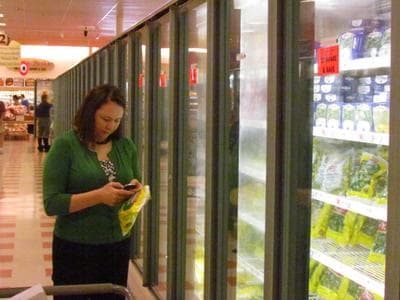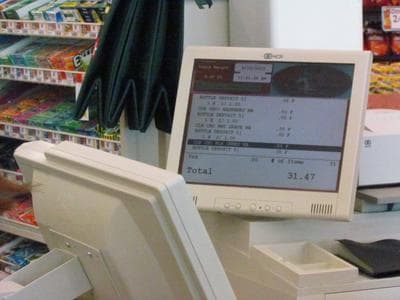Advertisement
I've Lived On Ramen, But I Failed The $4.50-A-Day Food Challenge

Could you live on $4.50 worth of food per day?
This past week I learned: I can’t.
Starting today, the state's secretary of Health and Human Services, John Polanowicz, and the commissioner of the Department of Transitional Assistance (DTA), Stacey Monahan, are taking on the "SNAP challenge" — to eat on a budget of $31.50 a week, the average weekly Supplemental Nutrition Assistance Program benefit in Massachusetts. They're doing it to make several points: to better understand what it's like to live on public assistance, to become a better advocate and, of course, to get attention.
According to the DTA, more than 800,000 people in Massachusetts receive federal SNAP benefits. Recipients qualify based on income and household size.
SNAP benefits — totaling about $81 billion a year nationally — have been in political hot water. Multiple budget plans debated in Congress propose spending cuts to the program. They include a plan to cut $20 billion from SNAP specifically and a plan by the House Agriculture Committee to reduce the farm and food bill, which SNAP falls under, by $3.5 billion a year.
At the Massachusetts level, the experiment comes just after a recent state auditor's report controversially raised questions about abuse and wastefulness in the program.
As Polanowicz, Monahan and U.S. Rep. James McGovern start their challenge, I will be ending my own week-long experiment in thrifty eating. I began the SNAP challenge last Wednesday, and ended up spending $33.40 for the week, even with some help along the way.
As a graduate student, I thought I was pretty well versed in stretching a buck. I’ve lived on the Ramen diet. But the SNAP program prioritizes nutritious eating rather than stacks of empty calories.
I shopped for a week of groceries last Wednesday at the Stop & Shop in my Dorchester neighborhood. My plan was to buy supplies for the entire week in one shot, trying to stay as health-conscious as I could within budget, and aiming to have some money left over should I need it before seven days was up. I bought two pounds of chicken, rice, a mix of vegetables and tomatoes for a total of $27.80. That left me with $3.20 and a pretty bland menu for the week.
That night, I cooked up three days' worth of food. I've never been known as a chef, so this in itself was a learning experience. Having those meals prepared saved me some time in the morning, and really did save some money.
I learned that healthy, price-minded eating takes a lot of planning. I rarely spend much time near my apartment, and after eating what I packed for Sunday, I was hungry enough later that night to spend some of my remaining money for a mini-sized burrito at Boloco. Between that and feeding what I’m ashamed to admit is a soda addiction, I broke the $31.50 threshold.
Toby Fisher, the executive director at the Massachusetts Public Health Association, advocates for healthy eating and says demonstrations like the SNAP challenge are important because they show not only the importance of food assistance programs, but where they fall short.
"Our concern with this benefit is that it is a low amount," Fisher said. "You can eat healthy for that amount, but you really need to work at it and that often can be difficult for low-income families. If you go to the supermarket, the cheap foods — the Ramen noodles, the pastas — are often not the healthiest. One can eat healthy, but you have to be educated, you have to read your facts, it's something that you have to pay attention to."
SNAP benefits aren't accepted at restaurants or vending machines, so emergency Boloco trips aren't an option for those who need the assistance the most. With few exceptions, most SNAP recipients must meet work requirements, so it's not hard to imagine this problem as fairly common.
Proper planning could have prevented it for me, but when you can only buy food from designated locations, what happens when you're stuck away from home for hours? Most of our foods these days are based on convenience; we’re almost trained to think of food in terms of convenience.
"We are entering a heightened health care crisis from eating so many processed foods and sugary sweet beverages," Fisher said. "And it's very economical and easy to go eat at a drive through. We are conditioned to find the easier route, which is often not the healthiest route."

Commissioner Monahan bought her supplies for the week at the Market Basket in Chelsea on Wednesday. It was exactly that reliance on convenience that had her worried as she shopped. She spent a lot of time comparing prices on items, something she admitted she didn't normally do.
"I don't prepare a lot of meals at home because of my schedule," she said.
Monahan said she had to make choices while she was shopping to get the most out of her allowance, like buying just two bananas instead of a whole bundle. Making these choices, and coming up just 3 cents shy of $31.50 at checkout, Monahan said the experience already gave her a sense of the anxiety of food insecurity and the relief of stretching a dollar or finding a deal.
Secretary Polanowicz told the State House News Service that while the week-long demonstration is meant to raise awareness and highlight the difficulties facing the recipients of income supplements, it doesn't compare with living off them for an extended period of time.
"To be clear, while Stacey and I will be doing this for a week, we understand that doing this for a week can't come close to the struggles low-income families have week after week," he said.
Fisher says those extra difficulties illustrate why we should be looking at more ways to help low-income families instead of considering spending cuts.
"Poorer and working-class families are often disadvantaged because they have more responsibilities, often less discretionary time and lack of transportation, so it's one more challenge upon them," he said. "This is why we need to keep the SNAP benefits and provide more educational opportunities."
That $31.50 fed me for five days, but it could have gone further with better planning and some experience. For example, Monahan paid 30 cents for yeast that she planned on using in an overnight bread recipe she crowdsourced from a friend.
Based on my own week on the SNAP challenge, I'd say that cutting benefits has the possibility of making an already difficult situation worse.